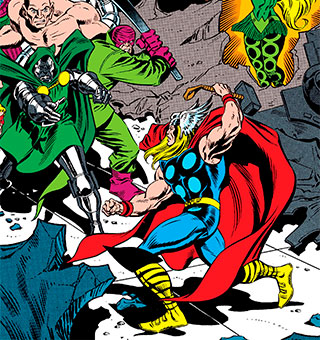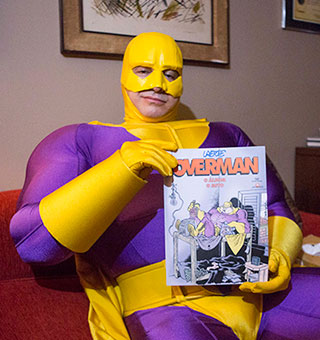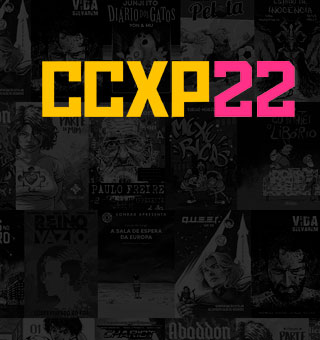A myth in the world of comics
 Joe Kubert, one of the world's most venerated artists |
Not many young readers remember the great artists of the past. And unfortunately few of those artists can still stir a passion in those reader's hearts, but there are exceptions and one of them is Joe Kubert.
At 75 Joseph Kubert, whose drawings have awed several generations of fans with such fine works as Tarzan, Hawkman, Enemy Ace, Sgt. Rock and Flash among many others, is still a big name in any comic convention.
The talented Joe Kubert has shown all his versatility in books as varied as Fax From Sarajevo, the The Preventive Maintenance Army magazine, Just Imagine Stan Lee Creating Batman with Joe Kubert, and even the Italian cowboy, Tex.
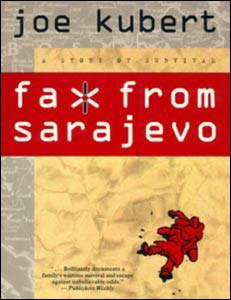 Fax From Sarajevo |
For several months Universo HQ wanted to make this interview, and we are honored that our good friend and great artist Sérgio Cariello (a teacher at Joe Kubert School) stepped in to help us and be our voice.
In the lines below you will find amazing things about this great master of comics, from his idols to his current projects. You will discover that he is the author of the first 3D comic book and that he worked at Will Eisner's studio at the early age of 12! We hope you enjoy the interview!
Universo HQ: When did you start working in comics? And why did you choose to do it?
Joe Kubert: Because I always loved comics and cartooning. I was 11 and a half years old when I got my first job. It was published. It was the first job I ever got paid for.
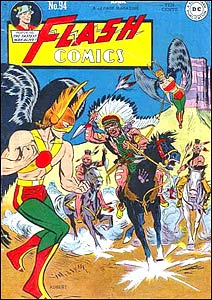 Flash Comics #94, april 1948 |
UHQ: What job was that? Do you remember?
Kubert: It was called Volton. I got paid five dollars a page. It was the first job that I got paid for.
UHQ: Any idols? Anybody you admire as an artist in particular that you follow?
Kubert: Many, many. The three main ones are: Hal Foster, who did Prince Valiant , Alex Raymond, who did Flash Gordon and Milton Caniff who did Terry and the Pirates . Those three were, at the time when I was young and became interested in comics, the best. Everybody knew them and they're still my favorites, even today.
UHQ: While doing Tarzan you followed after Hal Foster, Burne Hogarth and Russ Manning. What did that represent to you in taking such a task after them?
 Tarzan #210, july 1972 |
Kubert: It was very exciting, very exhilarating and very rewarding because when the Burroughs people came to talk to DC or vice versa, maybe DC came to the Burroughs people, they asked for me to do the Tarzan strip.
The Tarzan strip that Foster did was one of the strips he did besides the Prince Valient. Before he did Prince Valiant he was doing Tarzan and, as a kid, that was back in the 30s, early 30s, when it first appeared in the newspapers, it was one of the main things that gave me the feeling that this was what I wanted to do… so now, years later, I have an opportunity now to do a strip that I loved when I was a child and it was very rewarding to me. I loved the opportunity.
UHQ: And Talking about Tarzan, you drew such dynamic lions and monkeys. Was that pure talent or a lot of research?
Kubert: [Laughter] Thank you for the compliment about the talent! I try to research everything as much as I can. I have many, many pictures, many visits to the zoos, to the Museum of Natural History and drawings and photographs of different animals, lions, gorillas, chimpanzees, monkeys and the foliage of trees… everything that I had to draw I had to see first.
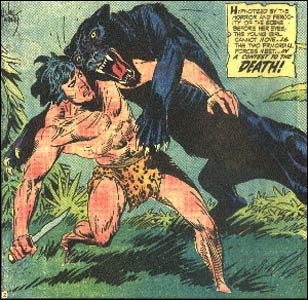 The dynamic art of Joe Kubert in the Tarzan series |
It's important for all cartoonists to draw these things as credible and as believable as possible. The stories are so imaginative and so off-the-wall that unless the drawings are credible, unless they can believe the drawings then there's nothing believable in the story and the whole strip is just a waste of time. So it's very important to do research.
UHQ: You answered my next question.
Kubert: Good [laughter]
UHQ: So let's go to the next one: Mighty Mouse 3-D! Published in the US. Was that really your idea?
Kubert: Yes. [Laughter]
UHQ: How did it happen? What was the outcome of that? Did it sell a lot?
Kubert:
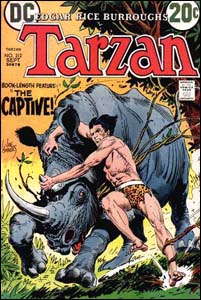 Tarzan #212, september 1972 |
Well, it built my first house! Yes, it sold a lot! [laughter] The idea came up when I got out of the Army, back in 1952. When I got out of the Army there were many magazines that were being published and there was much competition. So what I and my partner Norman Maurer (wonderful artist and wonderful creative talent) tried to think about was something that would be a little different than all the other comic books there were on the stands.
When I was in the Army I was stationed in Germany and I had seen some magazines, some publications with these green and red pictures, 3-D pictures with green-red glasses. We were talking about this and I remembered what I had seen and I told Norman: "Gee, it would be great if we could do a comic book that included the glasses so that the characters could 'jump off' the page". And so we worked on it and developed it and the first Mighty Mouse came out. The first book was quite a difficult thing to put together. We knew that the 3-D worked but the whole idea was to be able to put it together so it would be at a feasible cost. All the comic books were10 cents at the time.
We knew that if we did anything that cost more than 25 cents we would price-out. Nobody would buy it regardless of what we were trying to sell. So we were able to put it together, including the glasses, and the drawings and everything for 25 cents a copy and the first book sold over one million and two hundred thousand copies.
UHQ: You've done so many projects. Any one project in particular you find your favorite or any favorite character?
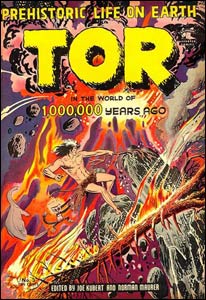 Tor #3, published by St. John, may 1954 |
Kubert: Well, Tor is my favorite character. Tor is actually a caveman dressed like Tarzan. That's why it's my favorite.
UHQ: In your hands Hawkman, Enemy Ace and Sgt. Rock had such great moments of success in comics, among the war comics. Why do you think these characters spent so much time forgotten?
Kubert: I have no idea, but they're still being published. Steve Lieber, a graduate of my School, just came out with a new Hawkman and I thought it was a beautiful job. Rags Morales, another School alumnus, penciled it and somebody else inked it, very, very nice job. I have a copy of it here. I think the letterer is also a graduate. It's thrilling to me to see people who attended here, like you (UHQ Note: Sérgio Cariello was a student of Joe Kubert School and he is an instructor now), to do well in the business and to do some really nice stuff .I'm as happy seeing that as if I was doing it myself.
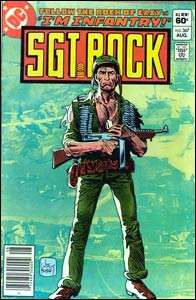 Sgt. Rock #367, august 1982 |
UHQ: As a matter of fact you're still working on Sgt. Rock, aren't you?
Kubert: Yeah. I'm going to be doing a new Sgt. Rock book. It's going to be written by Brian Azzarello and contracts are just signed and it's going to be 130 pages, including art and covers.
UHQ: So the editors didn't loose interest in these stories after all.
Kubert: No, no. They're doing all the Sgt. Rock and Tor's stories in the Archive Form as well. So old strips never die! They always get reprinted [laughter].





